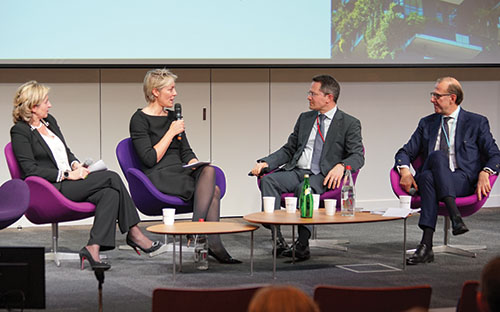Can the record investment into real assets reach new levels? Is their supply sufficient for the market? Would newer assets be of lower quality?
These were among the key questions on real assets debated on a panel session at the SGSS European Investor Summit.
In addition, the panel discussed whether these illiquid assets that make up the real assets universe are there merely for diversification – or whether they form a strategic allocation in their own right.
Karine Szenberg, Schroders’ head of Europe, said interest in real assets was not a recent phenomenon and the demand “is something that is going to stay” and continue to develop.
“It is already a large part of allocations – but now it’s opening up much more in a broader range of asset classes,” she said. “Investors are diversifying their allocation within private assets, including specialised real estate and infrastructure strategies and thematic and impact private equity.”
Asked whether private assets had become a strategic component of investor allocations, Inès de Dinechin, chief executive of Aviva Investors in France, referenced recent regulatory changes that presented the banking sector with an opportunity to change the dynamics of these markets.
She added that negative yields in bond markets and loss of fundamental value in equities, and the way that markets might be sometimes disconnected due to over-liquidity, were also influencing investors’ asset allocations.
“All these elements, if you put them altogether, create a lot of issues for investors: the search for diversification, problems in terms of stability for the balance sheet [of] insurers, for example, creating issues for capital volatility.” When real assets arrived on the potential buy-side for investors, she said, investors were able to access “something which brings a new diversification”.
Matching liabilities
Axel-Rainer Hoffmann, chief investment officer of Germany’s Volkswohl Bund insurance group, said real estate had, in the past, been a default option for managing liabilities, before sophisticated asset-liability management techniques such as liability-driven investment, known as ‘LDI’, came about. There was “just a gut feeling that real estate is a good natural fit to the liabilities”, he added.
A few years ago, his firm had come to the conclusion that all alternative assets were valid and important among its strategic asset allocation.
“For us, our target quota is one third, so 33% of all our investments, and we are already close to 30% right now, so I think we are a little bit above average when compared to the German market,” Hoffmann said.
“For us, it’s really important because we see that as a good match to our liabilities, even though from an asset-liability management perspective, the duration of it is zero.”
Hoffman said Volkswohl Group started to invest in onshore windfarms several years ago when returns were around 7% a year, but pulled out when returns sank. “For us, the returns are too low, so we don’t invest there any longer. That’s when you need to look for the next opportunities in the market, and there you get to other types of infrastructure such as roads, bridges, railroads and so on.” He added: “It would be great if we could convince German politicians that it makes sense to invest in infrastructure like 5G mobile connectivity.
“In a broader sense, all the investments that really foster sustainability – whether it is energy efficiency or nutrition projects or helping efficiency in farming – are big areas for all of us that will develop and where we could invest a lot.”
Different profiles
Giuseppe Oriani, chief executive for Europe for Savills Investment Management, said that real estate “is a universe of different profiles of investment in itself”.
“You can look at real estate, breaking it down to the end use of the product, and then have products which are very correlated to the macroeconomic trend and you may have products which are totally unrelated to the macroeconomic trends to a certain extent,” he said.
“It is quite clear that investing in social infrastructure real estate, whether it is in housing, nursing homes or healthcare-related facilities, there is a degree of correlation to the economic trend which is way lower than what could be the case if you invest in logistic assets, which are linked to the macroeconomic trend in a specific area or region.
“We try and define what our goals are and then define the investment strategies that really meet the overall objectives.
“A very large portion of the overall portfolio of large institutional investors is clearly in real assets rather than in more liquid assets only.”
©2019 funds europe





